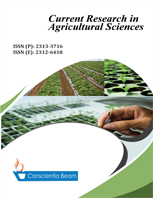Production Efficiency of Sesame in Selamago District of South Omo Zone, Southern Ethiopia
DOI:
https://doi.org/10.18488/journal.68/2015.2.1/68.1.8.21Abstract
The aim of the present study was to measure the levels of technical, allocative and economic efficiencies of sesame producer and identify factors affecting them in selamago district of south Omo zone, Southern Ethiopia. The study was based on the cross – sectional data collected in 2011/12 production season from 120 randomly selected farm households. Stochastic production frontier model was used to estimate technical, allocative and economic efficiency levels, whereas Tobit model was used to identify factors affecting efficiency levels. The results indicated that there was substantial amount of inefficiency in sesame production in the study area. Accordingly, the mean technical, allocative and economic efficiencies of sample households were 67.1 per cent, 67.25 per cent and 45.14 percent respectively. Labor and seed were the variables that positively affected the production of sesame. Results of the Tobit model revealed that soil fertility, non farm income and credit access positively and significantly affected TE. Soil fertility had positive and significant effect on AE. On the other hand experience in sesame production, distance of sesame farm form residence, non farm income and extension contact affected AE negatively and significantly. Soil fertility, non farm income and credit access had positive and significant impact on EE. However, extension contact affected EE negatively and significantly. These indicate that there is a room to increase the efficiency in sesame production of the study area. Therefore, government authorities and other concerned bodies should take into consideration the above mentioned socio economic and institutional factors to improve productivity of sesame in the study area.

